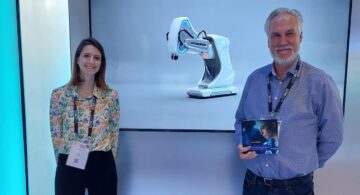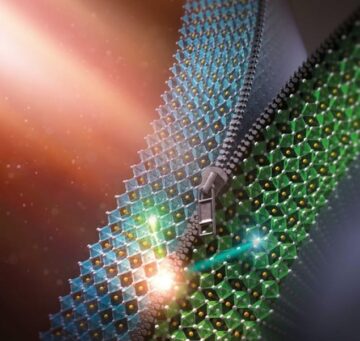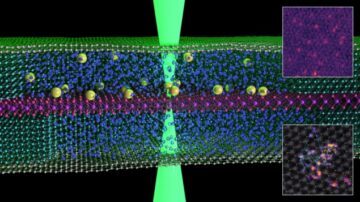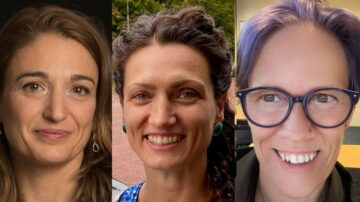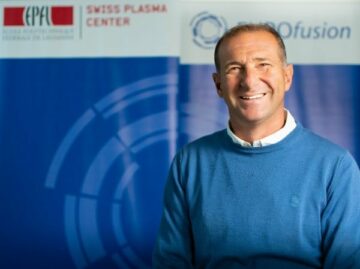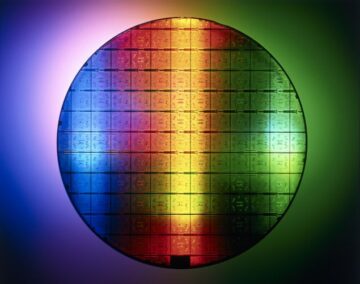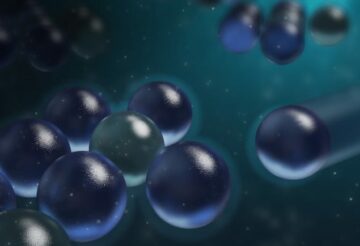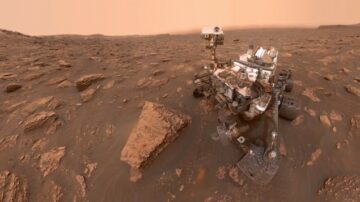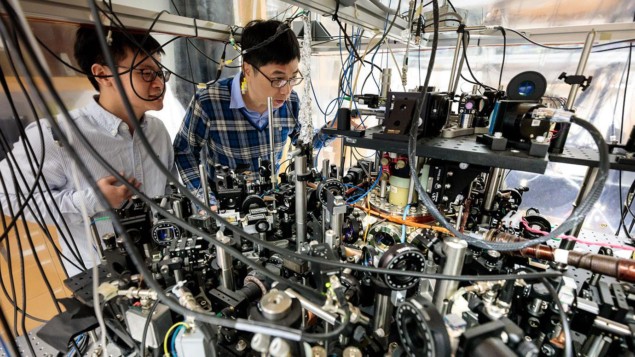
Chemical reactions are like a dance between atoms and molecules. As the dancers bounce into each other, they may react to form new combinations, or they may not. The whole process is incredibly complex and unpredictable, with many possible outcomes.
One way to simplify this dance would be to place the reactants into a single, combined quantum state. Under these circumstances, all the reacting atoms or molecules would behave similarly – more like a line dance, less like a mosh pit – and the reaction would proceed at an accelerated rate. This quantum-assisted speed-up is known as quantum superchemistry, and theorists have long predicted that it should be possible.
Researchers at the University of Chicago, US, have now spotted the first experimental evidence of quantum superchemistry in a gas of caesium molecules. The result paves the way for a deeper understanding of chemistry and an enhanced degree of control over chemical reactions.
Ultracold chemistry
To achieve this feat, a team led by Chicago’s Cheng Chin began by loading caesium atoms into an optical trap and cooling them to temperatures close to 0 K. Such extreme cooling is typical in the field of ultracold chemistry because it means that the atoms and molecules present can only exist in their lowest-energy quantum ground states. This is ideal for studying chemistry at its fundamental level, as it reduces the complexity of reactions significantly.
Once the caesium atoms were in this collective ground state, which is known as a Bose-Einstein Condensate (BEC), the researchers used an applied magnetic field and a so-called Feshbach resonance to tune the strength of the interactions between the atoms. This process converts the atomic BEC to a molecular BEC. The team monitored the dynamics of the molecule-creating reaction at the resonance, then continued monitoring after the magnetic field was turned off. At this point, the researchers imaged the unpaired atoms and newly-created molecules independently.
All for one
When the researchers analysed their data, they found that molecule formation accelerated at the value of the magnetic field that corresponded to the Feshbach resonance. The observed reactions quickly reached an equilibrium and were followed by coherent oscillations between atoms and molecules as pairs formed and broke. When the magnetic field was switched off, the reactions slowly decayed. Notably, a reaction known as three-body recombination, in which three caesium atoms come together to form Cs2 and Cs, was especially favoured.
The researchers also analysed the influence of particle numbers on the reaction dynamics and found that it fitted well with a quantum field model. In particular, they saw evidence of the so-called Bose enhancement – the tell-tale sign of quantum-accelerated reactions – in the faster oscillations that occurred at higher sample densities.
According to Chin, these experimental results lined up with theoretical predictions. “This has been a scientific goal for 20 years, so it’s a very exciting era,” he told the University of Chicago press office. Traditional chemistry, he added, is like “rolling the dice”, with reaction outcomes dependent on probability. With the new technique, one can steer the molecules into an identical state.
Although this experiment was performed with simple, two-atom molecules, the team plan to work their way up to handling larger and more complex molecules. “How far we can push our understanding and our knowledge of quantum engineering, into more complicated molecules, is a major research direction in this scientific community,” Chin said.
A specific kind of chemical reaction
Uwe Fischer, a physicist at the Seoul National University in Korea who was not involved in the research, notes that the chemical reactions studied in this work are defined in a rather narrow and specific context that will be unfamiliar to many chemists. Nevertheless, he says the result is important because it marks the first time that superchemistry has been observed experimentally.

Interactions between ultracold molecules controlled by physicists
Florian Schreck, a physicist from the University of Amsterdam in the Netherlands who was also not involved in the research, agrees that the result is crucial for this sub-section of quantum chemistry, as it verifies something that was predicted a long time ago, but was never previously seen. He attributes some credit for the result to the “exquisite control” the researchers had over their experimental set-up, such as the stability of the magnetic field. He adds that the many-body quantum effects the Chicago team see at work in a chemical reaction can probably be extended to more complex situations, giving tighter control over reactions at ultracold temperatures. Finally, Schreck notes that the experiment adds a lot of detail on what happens during a reaction, which should help theorists refine their models.
The research is described in Nature Physics.
- SEO Powered Content & PR Distribution. Get Amplified Today.
- PlatoData.Network Vertical Generative Ai. Empower Yourself. Access Here.
- PlatoAiStream. Web3 Intelligence. Knowledge Amplified. Access Here.
- PlatoESG. Automotive / EVs, Carbon, CleanTech, Energy, Environment, Solar, Waste Management. Access Here.
- PlatoHealth. Biotech and Clinical Trials Intelligence. Access Here.
- ChartPrime. Elevate your Trading Game with ChartPrime. Access Here.
- BlockOffsets. Modernizing Environmental Offset Ownership. Access Here.
- Source: https://physicsworld.com/a/quantum-superchemistry-emerges-in-the-laboratory/
- :has
- :is
- :not
- :where
- $UP
- 20
- 20 years
- 90
- a
- AC
- accelerated
- Achieve
- added
- Adds
- After
- ago
- All
- also
- amsterdam
- an
- and
- applied
- ARE
- AS
- At
- attributes
- BE
- BEC
- because
- been
- began
- behave
- between
- Bounce
- Broke
- but
- by
- CAN
- Chamber
- chemical
- chemistry
- Chemists
- Cheng
- chicago
- chin
- circumstances
- Close
- COHERENT
- colleagues
- Collective
- combinations
- combined
- come
- community
- complex
- complexity
- complicated
- components
- context
- continued
- control
- controlled
- corresponded
- credit
- crucial
- cs
- dance
- data
- deeper
- defined
- Degree
- dependent
- described
- detail
- direction
- during
- dynamics
- e
- each
- effects
- emerges
- Engineering
- enhanced
- Equilibrium
- Era
- especially
- evidence
- exciting
- exist
- experiment
- experimental
- extreme
- far
- faster
- feat
- field
- Finally
- First
- first time
- followed
- For
- form
- formation
- formed
- found
- from
- full
- fundamental
- GAS
- Giving
- goal
- Ground
- had
- Handling
- happens
- Have
- he
- Heart
- help
- higher
- HTML
- http
- HTTPS
- ideal
- identical
- image
- important
- in
- incredibly
- independently
- influence
- information
- interactions
- into
- involved
- issue
- IT
- ITS
- John
- jpg
- Kind
- knowledge
- known
- korea
- lab
- laboratory
- larger
- Led
- less
- Level
- like
- Line
- lined
- loading
- Long
- long time
- looking
- Lot
- Magnetic field
- major
- many
- max-width
- May..
- means
- model
- models
- molecular
- molecule
- monitored
- monitoring
- more
- narrow
- National
- Nature
- Netherlands
- never
- Nevertheless
- New
- notably
- Notes
- now
- numbers
- observed
- occurred
- of
- off
- on
- ONE
- only
- optical
- or
- Other
- our
- outcomes
- over
- pairs
- particle
- particular
- performed
- photo
- Physics
- Physics World
- PIT
- Place
- plan
- plato
- Plato Data Intelligence
- PlatoData
- Point
- possible
- predicted
- Predictions
- present
- press
- previously
- probability
- probably
- proceed
- process
- Push
- Quantum
- quickly
- R
- Rate
- rather
- RE
- reached
- React
- reaction
- reactions
- reduces
- refine
- research
- researcher
- researchers
- resonance
- result
- Results
- Said
- saw
- says
- scientific
- see
- seen
- Seoul
- should
- sign
- significantly
- Similarly
- Simple
- simplify
- single
- situations
- Slowly
- So
- some
- something
- specific
- Stability
- State
- States
- strength
- studied
- Studying
- such
- switched
- team
- that
- The
- the Netherlands
- their
- Them
- then
- theoretical
- These
- they
- this
- three
- Through
- thumbnail
- tighter
- time
- to
- together
- traditional
- true
- Turned
- typical
- under
- understanding
- unfamiliar
- university
- University of Chicago
- unpredictable
- us
- used
- Vacuum
- value
- very
- was
- Way..
- we
- WELL
- were
- What
- when
- which
- WHO
- whole
- will
- with
- Work
- world
- would
- years
- zephyrnet


